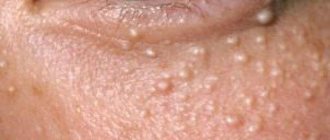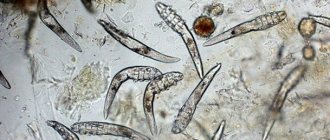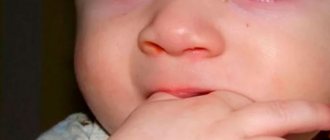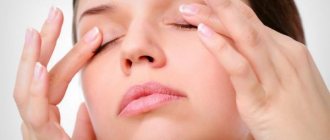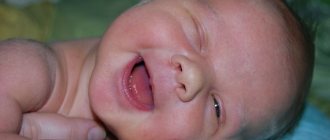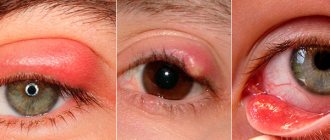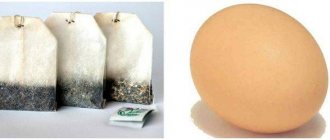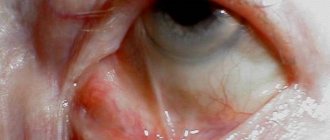Symptoms and risk factors
Every day, many adverse factors affect the eyes: wind, street dust, allergens, smoke, lenses, eyelash extensions. Any of these factors can cause dandruff on your eyelids. Together with scales, additional symptoms of the disease often come to life:
- itching, burning;
- general fatigue;
- swelling of the eyelids;
- dry eyes.
If treatment is not started in time, the condition will worsen:
- purulent crusts will appear on the eyelids;
- the hairs of the eyelashes will be glued together in the morning;
- Ulcers will appear around the edges of the eyes.
Diseases that can cause dandruff on eyelashes
Blepharitis
A common disease of the eyelid margins is blepharitis. It can be caused by a lack of vitamins, weakened immunity, diabetes and infections developing in the gastrointestinal tract, nasopharynx or oral cavity. Also unfavorable factors are poor hygiene, dirt, and dust in the air.
Types of blepharitis
There are several types of blepharitis, differing in symptoms.
- Scaly (seborrhea). The eyelids become red and thick, there is itching, photophobia, and narrowing of the palpebral fissure. White or yellowish scales appear on the eyelashes, at the very base. They look a lot like dandruff. Under them, the skin of the eyelids is reddish, sometimes blood vessels are visible, and the eyelids itch. Increased response to dust and wind. My eyes get very tired in the evening. Without treatment, the situation worsens and the disease becomes protracted.
- Ulcerative. Severe form, accompanied by pain. Most often appears at a young age. Scales and bleeding crusts form on the eyelids. The crusts fall off along with the eyelashes, and pus is released from the formed holes. New eyelashes begin to grow in a different direction. In some cases, scars and entropion of the eyelids form. If treatment is not started in time, inflammation will spread from the eyelids to the cornea and conjunctiva.
- Meibomiev. Characterized by inflammation of the meibomian glands. They are located in the cartilage of the eyelids. When pressed, a yellowish liquid appears, and purulent discharge appears in the corners of the eyes. Often the disease is accompanied by conjunctivitis.
- Demodectic. The cause of this blepharitis is the Demodex mite, which lives in the eyelash follicles. All people have it, but it is active only under certain conditions. Most often this is due to decreased immunity. The disease is characterized by the following symptoms: severe itching, which is especially disturbing in the morning, after sleep. The eyelids thicken and turn red. White flakes, similar to a collar or muff, form at the base of the cilia.
- Allergic. This blepharitis is often accompanied by conjunctivitis. The cause of the disease is the body’s sensitivity to medications, cosmetics or other substances. Often allergies occur due to contact with pollen, wool, dust, fluff and household chemicals. Blepharitis begins suddenly, the eyelids swell, tears flow, there is pain in the eyes, and photophobia is present. In the chronic form, the eyelids are very itchy. Exacerbation often occurs during the flowering period.
Blepharitis is also classified by location:
- anterior marginal, when only the area of cilia growth suffers;
- posterior marginal, when the meibomian glands become inflamed, which provokes inflammation of the conjunctiva and cornea;
- angular, when inflammation of the corners of the eyes is observed, occurs with purulent discharge, thickening of the eyelids and the formation of ulcers.
Eyelash mite
As already noted, eyelash mites are present on the eyelashes of every person. It does not cause harm until conditions arise that are suitable for active life of the parasite.
In the early stages, the disease is easily treatable.
Eyelash mites are a common cause of dandruff on eyelashes. It is a parasite measuring 0.5 mm. It is impossible to see him. It feeds on dead cells and secretions from the sebaceous glands.
There is no exact data on why eyelash mites suddenly begin to actively reproduce. Risk factors include lack of vitamins or other nutrients and weakened immunity. The disease can also be caused by:
- other past illnesses;
- improper or poor nutrition;
- poor hygiene;
- abuse of cosmetics;
- hormonal imbalances;
- stress and overwork;
- chronic lack of sleep;
- alcohol consumption;
- oily skin.
The tick itself is not dangerous, but its waste products are toxic and cause irritation and inflammation of the skin.
Symptoms of demodicosis are recorded not only in the eyelash area, but also in the ears, under the nose. Signs of the disease appear as:
- itching, burning;
- white coating;
- redness of the eyes;
- tearfulness;
- blurred vision;
- swelling of the eyelids, swelling.
The symptoms are especially noticeable in the morning, after sleep. It’s hard to open your eyes, there’s a crust on your eyelashes that sticks the hairs together.
Conjunctivitis
The cause of white flakes on eyelashes may be conjunctivitis. The main symptom of the disease is a sticky discharge that is difficult to remove. Pus accumulates during sleep, in the morning it dries out and becomes like flakes of dandruff.
Other symptoms of conjunctivitis:
- burning and itching, sensation of a foreign body in the eye;
- blurred vision, fog effect;
- lacrimation;
- sticky eyelashes in the morning;
- redness of the eyes;
- swelling of the eyelids.
There are different types of conjunctivitis.
- Allergic. Occurs when allergies to pathogens worsen.
- Viral, also called colds.
- Gonococcal. Caused by the microbe gonococcus.
- Diphtheric. Occurs in patients with diphtheria.
Any type of disease is accompanied by an inflammatory process. Self-medication in this case is contraindicated, because only a doctor can determine the etiology of the disease and prescribe adequate therapy. For a viral illness I prescribe antiviral drugs, for an allergic illness - antihistamines, for a bacterial illness - antibiotics. Often an additional course of multivitamins is prescribed.
Pediculosis
Dandruff on eyelashes is possible due to lice. With the appearance of parasites on the hair, a characteristic itching occurs. Particles of dead epithelium and waste products of lice fall on the eyelashes and are perceived as dandruff. You can also see the nits themselves, because they, like lice, feel great on the scalp, eyebrows and eyelashes, in the beard and mustache.
Pediculosis occurs not only on hair that lacks proper hygiene, but also on absolutely clean hair. The main route of infection is contact (from person to person, from objects, clothing, combs, bed).
It is not difficult to cure the disease; the main thing is to be systematic and follow the doctor’s advice.
Blepharitis
This disease has several varieties, there is scaly, seborrheic, ulcerative blepharitis. They, in turn, are divided into infectious and non-infectious forms.
The first are caused by fungi, house mites and staphylococcal infection.
The second option is provoked by the following reasons:
- The harmful effects of UV radiation;
- Avitaminosis;
- Intoxication of the body;
- Incorrectly selected glasses;
- Elevated sugar levels (not necessarily diabetes mellitus);
- Severe air pollution (gas pollution, dust);
- Worms;
- Problems with the gastrointestinal tract;
- Decreased immunity;
- Lack of personal hygiene.
But the symptoms in both cases are similar:
Dandruff appears in the form of small scales along the edge of the eyelid at the base of the eyelashes. In color they can be either white or yellowish-gray. When the scales are torn off, ulcers or a yellow crust remain underneath. The eyelids thicken and redden, the eyes water, quickly get tired, and there is a strong sensitivity to sunlight, wind, and dust. Itching occurs, which intensifies in the evenings, the eyelashes stick together.
Treatment for this diagnosis is provided general and local.
General therapy includes strengthening the immune system, a nutritious diet, and timely hygienic eye care.
For local treatment the following is prescribed:
- Ointment for direct application: “Tetracycline”, “Cortisone”, “Dibiomycin”, or “Chloramphenicol”.
For blepharitis, the product “Blepharogel” is used; it can also be used for preventive purposes as a cosmetic gel for the care of the skin of the eyelids, lubricating them after removing makeup.
Scaly blepharitis is also treated with this drug. In this case, all scales and dandruff from the skin and eyelashes should be carefully removed with a cotton swab dipped in Blefarogel.
With ulcerative blepharitis, all crusts are periodically removed as they appear. They are pre-soaked by pressing a cotton pad soaked in a weak solution of potassium permanganate, a decoction of herbs or strong tea leaves against the eyelids. Then, using tweezers, the scabs are removed, revealing small sores. They are lubricated with brilliant green, very carefully so that the product does not get into the eyes.
You need to treat it very often, up to 10 (!) times a day, because if you let the ulcer dry out, a crust will form on it again. And you'll have to start all over again.
- “Sodium sulfacyl” (solution) is used as an antiseptic;
- To soften the skin of the eyelids, relieve swelling and redness, use “Syntomycin” (1% emulsion or fish oil)
Other causes of dandruff on eyelashes
Not only viral or bacterial infections can cause the formation of white or yellowish flakes on the eyelashes. Also at risk of dandruff:
- untimely, inadequate care;
- use of low-quality cosmetics;
- poor nutrition;
- general weakness of the body.
To get rid of a disease, you need to eliminate the root cause. For example, normalize your diet, give up foods that have a detrimental effect on the condition of your skin and hair (spicy, salty, fatty and smoked foods).
If it's a cosmetic issue, you need to change it. You should trust proven products, choose products according to your skin type, and check the expiration date. Sometimes it is beneficial to completely avoid cosmetics.
It is recommended to establish a rational daily routine, spend more time outdoors, avoid stress, get enough sleep, and give up bad habits.
Why the disease occurs: causes of blepharitis
Often, blepharitis occurs due to infections or is caused by an allergen. It has been established that an important condition for the development of this disease is a decrease in the patient’s immunity.
The main reasons for the development of the disease among adult patients:
- Allergy, stye of the eyelid (long lasting), anemia;
- Reaction to cosmetics;
- Prolonged stay in very dusty places, in the sun;
- Eye diseases (astigmatism or myopia);
- If the patient's eyelid suffers from demodicosis;
- For autoimmune lesions arising due to chronic inflammatory processes in the body.
Sometimes a child's body begins to suffer from blepharitis. The main cause of this disease in a child is Staphylococcus aureus. But sometimes the disease appears due to hypothermia or dust in the eyes.
In addition, it has been established that the disease develops due to high load on the eyes and physical stress. Children with metabolic disorders, diabetes mellitus, and gastrointestinal pathologies are at risk.
The main factor provoking blepharitis is considered to be reduced immunity. With anemia, hypovitaminosis, and hormonal changes in adolescents, it is important to prevent the development of a chronic inflammatory process.
Features of treatment
The main thing when treating dandruff on eyelashes is to determine the root cause. If therapy does not produce results for a long time, it is important to do additional research.
In laboratories they carry out:
- biopsy (if blepharitis has prolonged, eyelid asymmetry or suspicion of carcinoma has appeared);
- microscopy of eyelashes (helps to identify demodicosis);
- bacterial culture study.
Treatment with medications may include:
- treating the surface of the eyelids with alkaline solutions;
- cleansing eyelashes with antiseptics;
- putting corticosteroids, antibiotics, or antiviral compounds into the eyes;
- instillation of drugs that imitate tears to eliminate dryness;
- applying ointments to the eyelids;
- placing gels and ointments under the lower eyelid;
- taking pills.
Tips for caring for eyelashes
Proper eyelash care is very important to prevent dandruff.
- Wash your face twice a day. There is no need to use soap; it is better to buy foam, gel or milk.
- Carefully remove mascara, shadows and other dyes from eyelashes and eyelids. Use special products, not just washing.
- Periodically apply burdock or castor oil to your eyelashes. This activates hair growth and helps get rid of scales.
- To soften the skin and provide nutrition to the follicles, you can use lotions with string, St. John's wort, calendula, and burdock.
Aloe Vera Gel
Aloe vera gel is one of those ingredients that acts as an all-round threat to dandruff. Not only does it remove bacteria/fungus that can cause eyelash dandruff, but it also soothes skin irritation and redness. In addition, it stimulates hair follicles and promotes new hair growth.
25 children of a childless man: an extraordinary reunion
Seven daily habits of happy people
Only on a soft spot: Russian Domostroy forbade punishing children in any other way
ethnoscience
The effectiveness of using traditional medicine recipes is questionable. Some tips, instead of improving, can, on the contrary, worsen the situation. If you decide to try a particular recipe, ask your doctor about the advisability of the measure.
We list the popular methods for eliminating dandruff from eyelashes.
- Infusion of eucalyptus and chamomile. Take a tablespoon of each plant and brew it with a glass of boiling water. The cooled infusion is used for washing in the morning and evening.
- Decoction of oak and linden bark. Boil linden bark and flowers for 5 minutes. When the liquid cools down, wipe the eyelids with it. Manipulations help relieve itching and reduce swelling.
- Strong tea. It is suggested to brew tea, wait until it cools down, and then use it for washing.
- Tincture of calendula.
